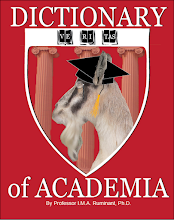Monday, June 29, 2009
IC Posts 2010 UT Budget
Wednesday, June 24, 2009
Blade Article on Teaching Loads
University of Toledo board OKs revised policy on faculty work
Goal is to ensure time in classroom
By MEGHAN GILBERT
BLADE STAFF WRITER
The University of Toledo wants to make sure its faculty is spending time in the classroom and will keep better track of work loads next school year.
"I want to be clear. … In my own belief a great majority, nearly all faculty members, are working hard and being productive," he said.
mgilbert@theblade.com
or 419-724-6134.
Tuesday, June 23, 2009
Live via the web—but live???
Town Hall Meeting Today: Main Campus Provost Rosemary Hagget will host a live Town Hall Meeting this morning at 11 a.m. via the web. You can watch and participate live, at http://video.utoledo.edu.
Send questions now or during the event to townhallquestions@utoledo.edu.
I don’t know about you, but when I think of participating live, doing it by video or e-mail is not what I think of.
Well, hey, here’s how to know when and where the Town Hall meetings are—don’t bother with the half-baked "selective" information in the e-notifications they send out; go straight to the President’s site:
http://www.utoledo.edu/offices/president/townhall/index.html
This lists all the meetings scheduled on both campuses from now through the end of next year (2010). Unless, of course, something gets changed or cancelled, with or without notice.
Oh—and, isn’t it Haggett???
Saturday, June 20, 2009
Ode
And sheds on our works a garish light
We labor with love, to make our own fate
And then is appointed some second rate
Burma Shave?
Or is it "Shave 'em Dry?"
That We May Bask in the Reflected Glory
Dr. Thomas E. Brady will be recommended to the UT Board of Trustees to assume the position of interim dean of The University of Toledo’s Judith Herb College of Education, at its meeting Monday, June 22, UT officials said Friday.
If approved, Brady, a former member of the board of trustees for the Medical University of Ohio and UT, will assume his new role beginning August 1. His term will run until July 31, 2010 or until a national search process has been completed and a permanent dean selected, according to his letter of appointment.
“Tom Brady joins the Judith Herb College of Education at a critical time,” said Dr. Rosemary Haggett, provost and executive vice president for academic affairs. “Tom’s experience as a leader and an entrepreneur will be critical to the college’s success as new instructional technologies and higher student expectations force colleges and universities across the nation to adapt as the world changes around us.”
Brady said one of his most important jobs when he assumes his new role will be to listen.
“I’m incredibly excited by this challenge and honored to have been asked to serve,” Brady said. “This is a college full of brilliant thinkers and powerful minds and I see my role as helping bring good ideas together, helping secure needed resources to ensure faculty and student success and, ultimately, ensuring the next generation of teachers is prepared to educate students in a technological environment very different from the one that exists today.”
Brady is chairman, CEO and founder of Plastic Technologies, Inc. He earned his Ph.D. from the University of Michigan and his master’s and bachelor’s degrees from Dartmouth College.
Haggett also emphasized the strides the Judith Herb College of Education had taken under retiring dean, Dr. Thomas Switzer.
“From overseeing the capital improvements to Gillham Hall, to helping form a relationship with Judith Herb and her family to harnessing the efforts of the college to a learning-focused pedagogy, the UT community and teachers and students all over the country owe Tom Switzer tremendous thanks for his lifelong contribution to education and for his leadership at The University of Toledo,” Haggett said.
Friday, June 19, 2009
Champions and Chairs
Thursday, June 18, 2009
Library Purge Accompanies People Purge
From: "Martin, Juan"
To: "Thompson-Casado, Kathleen S."
"Emonds, Friederike"
"Dick, Warren H."
"Semaan, Gaby "
"Lepeley, Oscar C."
"Cheng, AnChung"
"Hara, Joseph"
"Hottell, Ruth Ann"
"Martin, Juan"
"Rouillard, Linda"
Subject: Carlson evaluation of monographs
Dear colleagues,
In the last couple of weeks I have been meeting and in contact with the
librarians concerning the revision of the library collection. The process
is going to be different from what we were informed some months ago. The
process will be as follows.
The collection is being evaluated in its entirety for the first time. The
librarians envision a core circulating collection, that is, items used
repeatedly and extensively for classroom assignments and research. They
have decided upon a basic policy ? if an item has not circulated in the
past 9 years, then it is evaluated for placement at the Northwest Ohio
Book Depository or withdrawal. Before an item is ever withdrawn from
the collection, they check for existing copies at the Depository, for how
many copies are available via Ohio LINK and if the title exists on a
standard core collection list. These standard collections are based on
the 2002 Best Books for Academic Libraries and the 2007 RCL: Resources
for College Libraries ? some of our librarians have contributed to the
latter. I have some reservations about this process (for example I could
not find a section on linguistics in the 2007 RCL: Resources for College
Libraries, we the instructors know what we are going to need in the
future for our classrooms, etc.) and I have asked for the lists to be
evaluated by us too.
The evaluation is starting with sets (titles that have multi-volumes such
as, vol. 1, vol. 2, etc. ? because they appear to have little to no
circulation). I have attached the particulars regarding the sets
evaluated to date. There are two lists: one of sets to be sent to the
Depository and another one of sets to be withdrawn. Please examine the
list and let me know if any of these sets should be kept at the library
or not withdrawn. Please consider the criteria that they are using (see
above) in your evaluation. As soon as they send me more list I will be
forwarding them to you.
A second and even more important issue is the budget freeze on new
acquisitions. I have noticed that none of the books that I have requested
to be purchased for the library in the last months have been acquired.
The librarians have confirmed this action. (They have assured me
that the budget freeze on new acquisitions is across all disciplines.)
The situation is not clear at this point for next fiscal year, and they
told me that they will keep us informed. Anyway I consider this is very
serious. If the university cannot purchase up-to-date materials for our
research and teaching how are we going to fulfill our mission? I think
that this issue should be discussed by the Executive Committee of the A &
S Council, Linda, as we talked, and may be other venues.
Please send me your evaluations, comments and reactions. Thanks in
advance.
Juan
Wednesday, June 17, 2009
FYI Reading Material
Schmidt, Peter. (2009, June 12). How to Fire Your President: Voting 'No Confidence' With Confidence. The Chronicle of Higher Education,http://chronicle.com/daily/2009/06/19892n.htm
| Å] |


